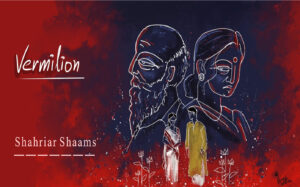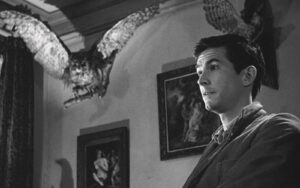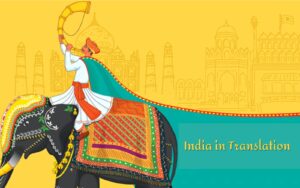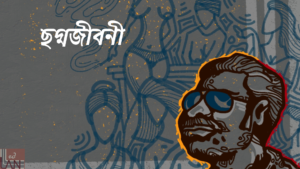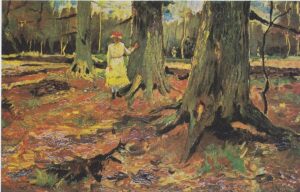Mohe Lagi Lagan Gurucharan Ki – Reba Muhuri
purab des se aayi goriya, jadua dar gayi re
that easterly beauty, came and bewitched all
~ from a dadra sung by Girija Devi
A Sojourn in Banaras
Satyajit Ray’s second and final Feluda film, Joy Baba Felunath (1979), is less a detective story than a cinematic vacation in the city of Banaras. It captures the idea of a middle-class Bengali holiday, from a time when places like Banaras, Deoghar, and Puri served the dual purpose of pilgrimage and vacation. Far from the madness of office-work (chakri) in Calcutta, exhausted bodies loved to elbow their way through the winding galis, as their tongues feasted on a steady supply of rabri, peda, khaja, and the like. These destinations offered the benefit of hawa-badal or ‘a change of air’, which was believed to have a curative effect on one’s health.[1]
The nature of transfer postings in colonial administrative services also ensured that people came and settled in these places. Thus, a significant section of the Bengali service-gentry settled in towns across the present-day states of Uttar Pradesh, Bihar, Jharkhand and Orissa, often playing critical roles in local institutions and business, and forging long-term ties with the place. Banaras certainly has a longer history of both Bengali habitation and travel that goes back to the eighteenth century. When Feluda arrives in Banaras, he puts up in the Calcutta Lodge run by a certain Mr. Chakraborty. Subsequently, the film unfolds in the house of the Ghoshals, a Bengali family that has resided in the city for three generations.
The film revolves around a stolen artefact that was gifted as a reward to an ancestor of the Ghoshals who served as a family physician to the king of Nepal. Joy Baba Felunath, as such, is remarkable in gesturing at histories of service and mobility, the exchange of gifts and their afterlives, and more broadly, the lives of a diasporic Bengali gentry in North Indian towns. Ray’s film predates the ‘cultural turn’ in South Asian historiography, when issues of culture and power—especially those relating to the service-gentry— emerged as worthy themes of research and writing [2]. In Ray’s film, these details come as part of a larger story, as they are more likely to happen in the lives of people, without the burden of retrospective analysis. So, one doesn’t miss the wood for the trees but in what follows, I shall try and stop by some of the trees.
Take, for instance, the music in Joy Baba Felunath. One of the most consistent background sounds in the Ghoshal house is that of the gramophone—the oldest member of the family, who is 84 and never shown in the film, listens to the recorded music of the masters in a loop. A servant is recruited for the sole purpose of manning the gramophone. The act of listening substitutes the eldest Ghoshal’s appearance in the film, and also works as a wonderful metaphor for his withdrawn presence in the household. The music is typical of the 78 RPM discs, and the first voice we hear is that of Kesarbai Kerkar singing the Bhairavi thumri ‘kahe ko dari gulal’. However, the eldest Ghoshal is not the only person that listens to music in the house. Bikash, the manager of the estate, tunes in to the Lucknow station of the radio to listen to ‘Akhtari’s ghazal’. By the time Ray made Joy Baba Felunath, the vocalist, Akhtari (Bai Faizabadi) had transitioned to Begum Akhtar. In fact the title credits in Jalsaghar (1958) recognise her as Begum Akhtar. Yet Ray retains ‘Akhtari’ in this film not without a reason— an older name is part of a code of listening and appreciation. These little details on the octogenarian Ghoshal and Bikash gesture at what the literary historian Francesca Orsini has called a ‘communit[y] of taste’ in a different context. Here, it heuristically refers to the shared and parallel practices of listening to recorded, transmitted and live music that allows us to locate the different members of the Ghoshal household in the same soundscape.
Towards the beginning and end of the film, music appears centre-stage as performance. Luckily, the performances are not set at the establishment of the tawaif, thus steering away from Bombay cinema’s favourite formula of depicting Hindustani music in cities like Banaras and Lucknow: music = tawaif = mahfil in the salon. The performances in the film take place on the riverfront instead, at the temporary dera of a god-man called Macchli Baba. A female singer sings to an audience of devotees under an open sky. We know that music is integral to such devotional gatherings, and just like the courtesan’s salon and the rais‘s drawing room in the nineteenth and twentieth centuries, temples and spiritual establishments encouraged regular performances by the city’s musicians. Not surprisingly, some of the city’s best tawaifs performed in these spaces. In these two performances, Ray infolds the music of Banaras in every sense— its timbre, literature, and listening public. For the Bengali viewer, it also became the quintessential sonic code for Banaras.
These songs— Mohe lagi lagan, He Govind rakh sharan, and Pag ghungru bandh— were sung by a Bengali singer Reba Muhuri. Muhuri was ‘discovered’ by Ray during the making of Shatranj ke Khiladi (1977) in which he wanted a voice that was closest to that of the singers of the mid-nineteenth century. Indeed, Muhuri’s was a suitable voice. She recorded two famous compositions for the film— the Banarasi bol-banao thumri Chhab dikhlaja banke sanwariya and the dadra Bajaye bansuriya shyam jamuna kinare. That Reba Muhuri’s voice could be representative of the music of both mid-nineteenth century Lucknow and mid-twentieth century Banaras tells us something about her singing and how people listened to it across the arc of time.
_____________________________________
[1] Besides places like Banaras, Allahabad and Puri, there were the more salubrious destinations like Madhupur, Jasidih, Simultala, and Hazaribagh, of which we have excellent accounts in Bengali writings.
[2] To be accurate, Karen Leonard’s important study Social History of an Indian Caste: The Kayasths of Hyderabad (University of California Press, 1978) appeared in 1978, which inspired further research into the histories of different kinds of service groups. However, it was only in the 1990s, with a more visible shift of emphasis from political economy to political culture, that the cultural productions of these service groups (and other kinds of social collectives) came to be seriously researched. As far as Banaras is concerned, one can think of Sandria Freitag’s edited volume Culture and Power in Banaras: Community, Performance, and Environment, 1800-1980 (University of California Press, 1989) as one of the early works in what is now a rather long bibliography.
A Suitable Voice
Reba Muhury sings a thumri in raga Mishra Bilawal, Bajawa re bar bar baje. We hear an elderly voice against the drone of the tanpura, and no other instrument. ‘Now listen to this, one of Badi Moti bai’s songs… the famous singer from Banaras. It is one of a kind on Ramchandra’s marriage procession. Only Badi Moti bai knew this song, and it was composed by her ustad, Moujuddin Khan sahab. All her ta’lim [training] happened under him.’
Reba Muhuri learnt it from her guru, Badi Moti bai. In her book, Thumri o Baiji (1986), she has recounted how she lived in Banaras to learn from Moti bai. This learning was a transmission of techniques unique to the purab-ang gayaki (lit. the eastern form of singing) of Banaras. It is through her memory of ta’lim that she touches upon elements like bol banana (musical exposition of the song text), pukar (lit. ‘to beckon’), and the mixing of raags in thumri. Muhuri inherited the music of Moujuddin Khan through Badi Moti and although she never mentions a formal ganda-bandhan ceremony, she was conscious of a musical lineage that she sometimes referred to in her performances. It is a lineage of style, of interpreting song-texts and inheriting ‘one of a kind’ pieces (like bajawa re bar bar) that connects Muhuri to Moti bai and Moujuddin across time. That Reba Muhuri’s music could recreate the soundscapes of earlier times finds resonance in the assessment of listeners who had heard her in the 80s and 90s—they often described her music as‘agey kar diner awaj’ (a voice from older times), ‘purono ganer khajana’ (a treasure of old songs)’.
Reba Muhury could sing like the tawaifs of Banaras, she could sing their songs. To many of her listeners, Reba Muhury’s voice was a priced echo, always replicating something original that was lost. Her music was like the inked rubbings of old inscriptions that epigraphists work with. The talim that she received from Badi Moti is akin to rubbing— the heart to heart (sina ba sina) transmission of techniques and interpretations. It is interesting how a particular way of singing could be seen as a bridge to the past. I remember the late Banaras vocalist Rajan Mishra, deeply immersed in his own singing and that of his brother, telling audiences what they sing is actually ‘buzurgon ka gana’ (the music of the old masters). It might seem like a fairly simple statement with an emphasis on ancestry, but it gestures at the possibility of reproducing the imagination of the past masters musically.
Besides audiences’ attempt at historicising Muhuri’s voice was her own interest in the lives of singers, particularly the baijis or tawaifs (professional hereditary women singers). Muhuri, like her musicologist father Amiyanath Sanyal, not only sang but also wrote on music. She has repeatedly acknowledged her father’s formative influence on her, and how music was integral to the friendship that they shared. In fact, Moujuddin Khan, who Muhuri had learnt to regard as a musical ancestor, was one of Amiyanath Sanyal’s favourite singers. Sanyal’s most-acclaimed work, Smritir Atale [In the Abyss of Memory] (1952) is a personal memoir of musicians he deeply admired: Moujuddin Khan, Faiyaz Khan, and Kale Khan. The first chapter is an account of Moujuddin Khan, who he had heard for the first time in a traditional mahfil in Gaya— another city like Banaras that fostered a range of intersecting commercial, intellectual, musical and devotional networks, and consequently, a Bengali diaspora. Before Moti Bai, it was Amiyanath who introduced his daughter to Moujuddin’s singing and his legendary charm, through personal anecdotes.
Personal anecdotes, as in her father’s writings, form the crux in Muhuri’s Thumri o Baiji. The ambiguous (and not merely marginal) social position that the ‘courtesan-singer’ came to occupy in the late nineteenth and early twentieth centuries attracted many thinkers to reflect on the sociology of female professional singing in North India— I can immediately think of Amrit Lal Nagar’s Ye Kothewaliyan (1965). Muhuri’s Thumri o Baiji is also an amateur ethnography of sorts. She attempted to understand the lives of the baijis, who were at once precious and precarious. To come as close to their experiences— sahanubhuti or compassion as a way of knowing, of entering the lives of others. There is an incident in which Badi Moti bai settles scores with a former patron in Banaras who had caused much harm to her reputation in her youth. Muhuri is not merely a spectator, she facilitates Moti Bai’s design. In doing so, she writes a social history of honour and respectability in Banaras— not as a historian, but as Badi Moti’s disciple, and perhaps most importantly, as another woman singer who was intellectually and emotionally invested in the question of respectability in contexts different from her own.
A Mahaul for Music
Reba Muhuri, much like her father, allows us to think about the writing of music by musicians. She was one amongst particularly talented author-musicians from similar or comparable social backgrounds. I am thinking of Dipali Nag (b. 1922) and Sheila Dhar (b. 1929). At the level of generalisations, we can say a few things about all three.
They all hailed from upper-caste, (English) educated service families with a flair for ‘education and the arts’ in late-colonial India. Dipali Nag’s father, J. C. Taluqdar, taught Mughal history at St. John’s College in Agra; Sheila Dhar was born in a family of Mathur Kayasthas in Delhi, that had rendered bureaucratic service to the Mughals and later, to the colonial state; and Reba Muhury’s father, Amiyanath Sanyal, was a medical practitioner and a bilingually published musicologist. Even though music was not pursued professionally in these families, it called for a serious engagement both at the level of training (talim) and connoisseurship, as a form of knowledge. In fact, some of these individuals emerged as bourgeois patrons of lineage-based musicians (gharanedar) at a time when courtly forms of performance that involved a set of interpersonal relationships were gradually giving way to the professionalism of music conferences, radio recitals and recordings. Patronage allowed proximity with the musicians, leading to frequent visitations and at times longer stays in the household of the patron/disciple. Take, for instance, the regular visits made by musicians at Sheila Dhar’s ancestral house in the Civil Lines. Of particular significance was the presence of the veteran sarangi-player Bundu Khan, and the relationship he shared with Dhar’s father, even after the former moved to Pakistan. The presence of musicians at home created a certain kind of sonic environment—a mahaul or poribesh —that inculcated a set of musical etiquettes and tastes in the children. This informal, almost observational training, was valued by parents like Amiyanath Sanyal, and formed a part of the child’s co-scholastic education. It is not surprising that in the writings of the author-musicians, we find frequent references to their parents as models of musical manners.
A related point, and one that is best seen in the writings of the author-musicians is that they were aware of the difference between them and the gharanedar/traditional musicians—not merely a difference in terms of inheritance and professionalism, but also a different temporal location. The hereditary musicians became emblematic of a certain nostalgia of the past, and it is here that the author-musician emerges as a chronicler of that nostalgia. They write about the ustad or the baiji almost in an ethnographic vein. There are also desires of travelling these distances, of singing their songs, living with them Indeed— probably a courage afforded by their firm footing in the present. And thus, Reba Muhuri ends up singing their songs, like them, and yet as “daughter and pupil of the eminent musicologist Amiyanth Sanyal”, as noted by the eastern zonal programme for Akashvani on 4 October, 1970.

